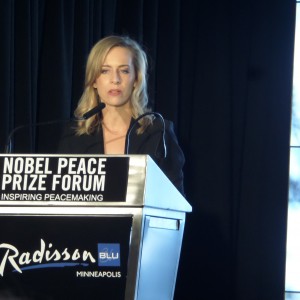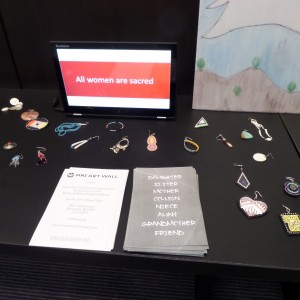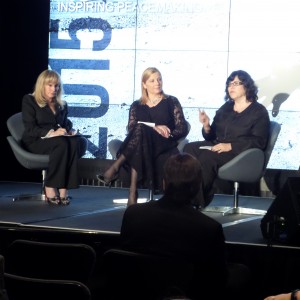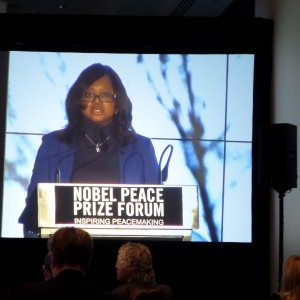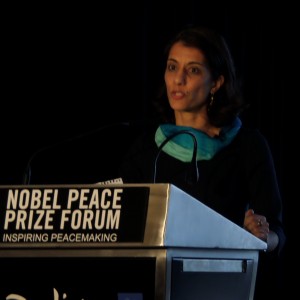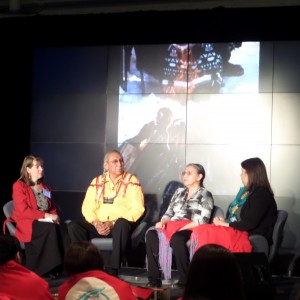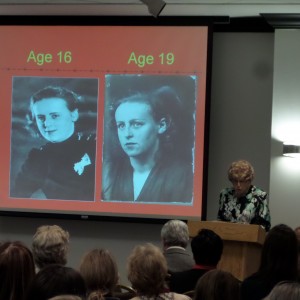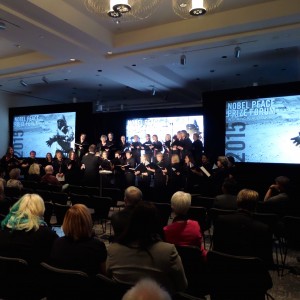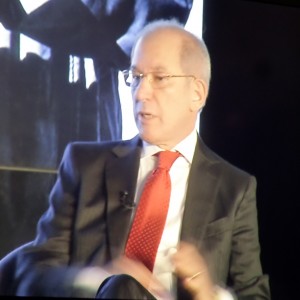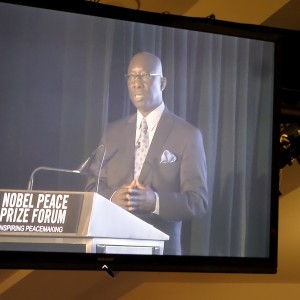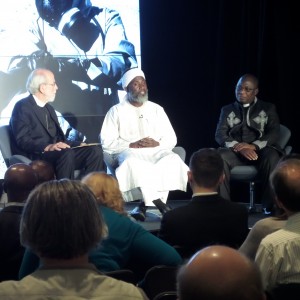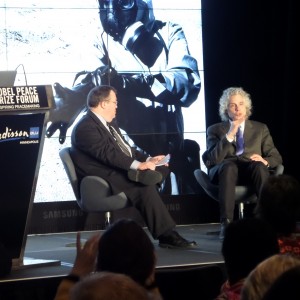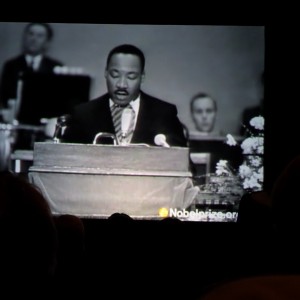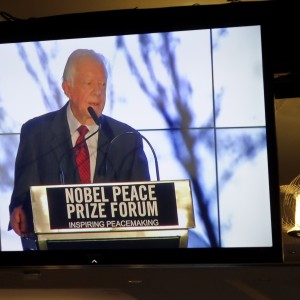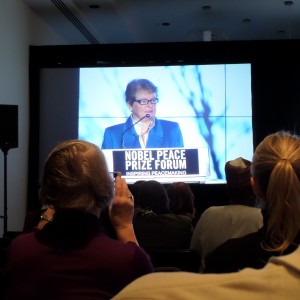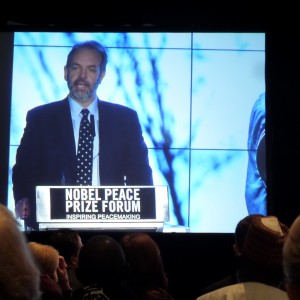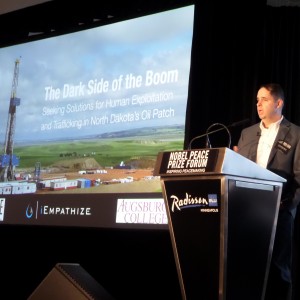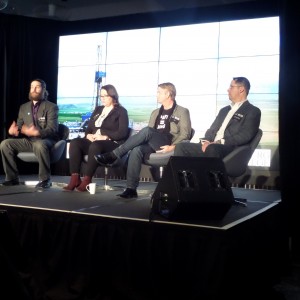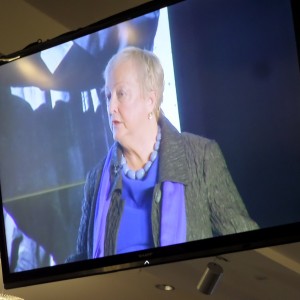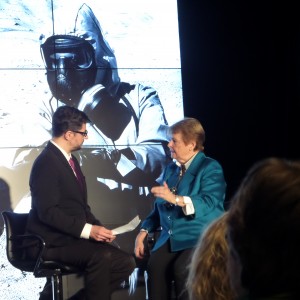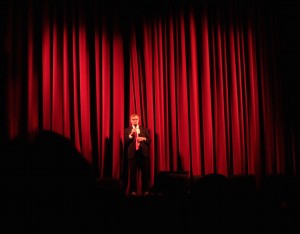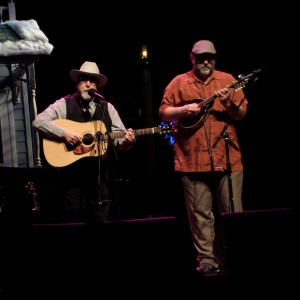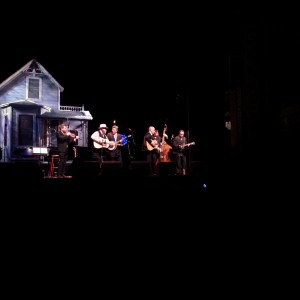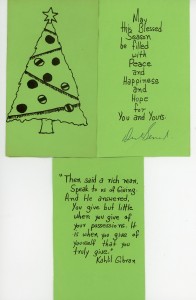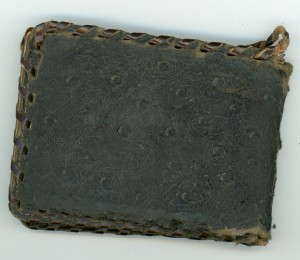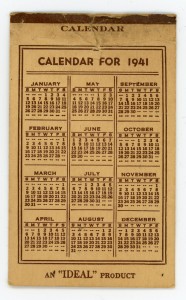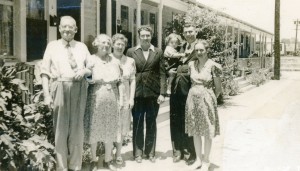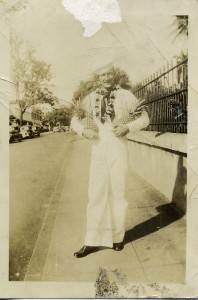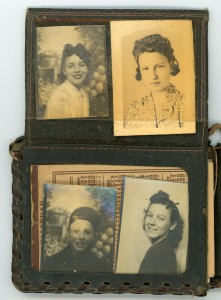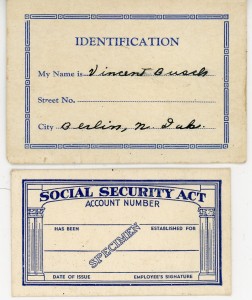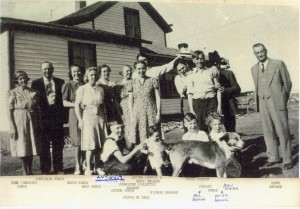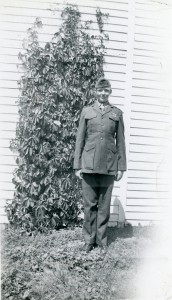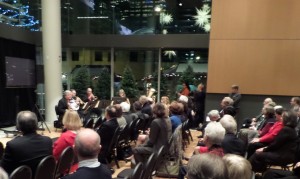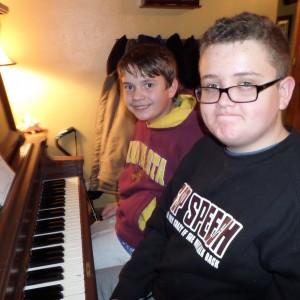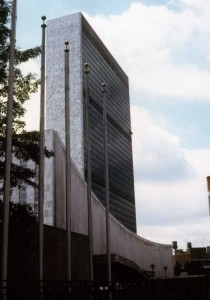
The United Nations Building, snapshot, June 30, 1971, Dick Bernard
Calendar/timeline for 2015, the 70th anniversary of the end of World War II spotlighting some significant dates in history:
Community of Nations 2015 calendar March 2016 edition.
Following Dr. Schwartzbergs comments (below) are links to 55 posts in 2015 which directly related to International Issues.
NOTE TO READERS: An addendum to the original edition of this post, Jan 1, 2015, included comments by Dr. Joseph Schwartzberg with a succinct history of the United Nations System and his ideas for reform. The remarks were included, with his permission, at the end of the original post.
In recognition of Dr. Schwartzbergs upcoming
Workable World Conference (Oct 9-10, 2015) I am moving his January 5, 2015 comments to the beginning of this revision, with other comments now at the end of the post.
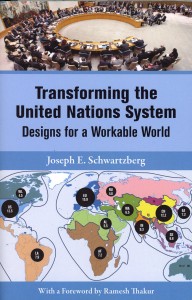
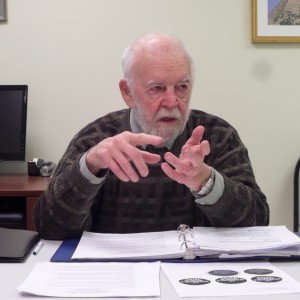
Dr. Joseph Schwartzberg, December 4, 2014
THE INTERNATIONAL SYSTEM: TIME FOR “ PLAN C”
In any given period, the international system is characterized by some minimally acceptable rules of order. These rules may be partially codified; but, to a large extent, they are tacitly understood, generally reflecting the balance of power perspectives of a small number of influential states. This essay considers systems in the period since World War II.
Plan A: Traditional Power Politics Plus a Weak United Nations System
The United Nations Charter, adopted in 1945, was not a democratic document. In the Security Council, the sole UN agency to enjoy binding powers, the so-called P5, the principal victors in World War II, were not only given permanent seats, but also the right to veto any resolution of which they disapproved. All other members reluctantly accepted this dispensation, relying for protection on their sovereign immunity from outside intervention. In theory, all states were sovereign equals. Each could do whatever it wished, no matter how immoral, within its own borders. Nor did it matter whether its actions were for the good of the planet. Nevertheless, most states behaved reasonably and the system worked well enough to help avert World War III and to provide modest benefits to needy nations.
In its early days, the UN was looked upon favorably by the United States, which, together with its allied and client states, mainly in Latin America and Western Europe, could win just about any vote in the UN General Assembly. The Soviet Union, naturally, frequently used its veto to block Western initiatives. But, as the UN expanded, mainly because of decolonization in Africa and most of Asia, the balance of power shifted. What had been a primarily East-West contest morphed into opposition between the global North and South. In the new power configuration the South won many victories, but they proved to be pyrrhic in that decisions were non-binding, unenforceable and largely ignored by powerful states. New agencies continued to be created to deal with issues of global importance, but they were typically under-funded and inadequately staffed. The United States continued to pay lip service to the importance of the UN, but we also made sure that it did not become a serious contender for global political power.
Overall, the planet continued to be wracked by political, economic and social injustice. Looming environmental dangers were ignored. Leaders and diplomats were largely oblivious to many mounting dangers and failed to recognize the sowing of the seeds of terrorism.
Plan B: An Abortive Pax Americana
With the unanticipated implosion of the Soviet Union in 1989, a seemingly promising new era dawned in world affairs. The United States emerged as the sole hegemon in a politically uni-polar world. Its capacity to lead was unprecedented. Many of our leaders, however, especially on the political right, perceived the global situation as enabling the establishment of a “New American Century,” a Pax Americana backed by worldwide acceptance of free-market capitalism and guaranteed militarily by “full spectrum dominance” (on land, sea, air, and outer space) and marked by pro-American, nominally democratic regimes on all continents. Remaining adversaries were to be hemmed in by a global network of hundreds of military bases. To be sure, it would be expensive; but it was a scenario we believed we could afford.
But there were problems. Nobody ever asked us to be the world’s policeman and political arbiter. We lacked the skill to export democracy to other lands. Most of the world did not buy into the neo-con myth that we were the “shining city on the hill” And then came 9/11! Our response was the unwinnable global War on Terrorism that has obsessed our political thinking ever since. Wars in Afghanistan, Iraq and other nations have wreaked incalculable death and devastation and drained our economy of trillions of dollars and precluded meaningful reforms in our own country and abroad. For all practical purposes, the UN was relegated to a bit and subservient part. And most of our political establishment still doesn’t get it.
Plan C: A Transformed United Nations System
All of the problems confronting our planet before 9/11 are still with us. Some, especially climate change, have become appreciably worse. Plan B isn’t working and needs to be replaced. We need truly global, not essentially unilateral decision-making. The United Nations must be transformed and strengthened. Decisions must be binding, democratically reached, accepted as legitimate, and enforceable. The global South deserves to have an appropriate voice in world affairs. Terrorism must be addressed, not by killing ever-greater numbers of presumed potential perpetrators, but by eliminating its root causes in global and local injustice. Ordinary citizens deserve to be represented in a World Parliamentary Assembly. Better ways must be found to tap the wisdom of civil society. Unilateral military adventurism must yield to duly authorized missions carried out by a competent standing peace force. The jurisdiction of the International Criminal Court must be made universal. The list goes on.
Happily, solutions are in sight. Suggesting how best to address these issues is the purpose of my most recent book, Transforming the United Nations System: Designs for a Workable World. The book, published by the United Nations University Press in 2013 has been enthusiastically endorsed by numerous prominent world thinkers. You may easily order a copy on-line from Amazon, Barnes and Noble, or the Brookings Institution Press.
*
(continuation of January 1, post)
Dick Bernard comments:
Do make it a priority to read Dr. Schwartzberg’s book on Transforming the United Nations System, and attend the
Workable World Conference, which is based on the book.
Most Recent Related Blog Posts, since January 1, 2015: (earlier posts are found at the end of this page.)
47.
Nov. 16, 2015 Paris, November 13, 2015
48.
Nov. 18, 2015 Paris, the 6th Day.
49.
Dec. 1, 2015 “Last Night I Had The Strangest Dream…A Million Copies Made”
50.
Dec. 4, 2015 San Bernardino
51.
Dec. 5, 2015
Christine Loys. A Message From COP 21, Paris, The Global Conference on Climate Change.
52.
Dec. 7, 2015 December 7, 2015: “War” to Peace: Changing the Conversation.
53.
Dec. 10, 2015 Muslims
54.
Dec. 14, 2015 The Paris Climate Talks Conclude…and Continue, and Begin
55.
Dec. 17, 2015 “Let There Be Peace On Earth And Let It Begin With Me.”
(click to enlarge)
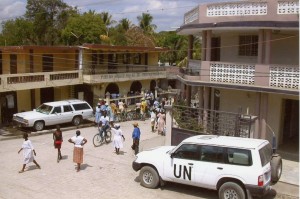
UN vehicle in Hinche (Ench) Haiti, March 2006
The United Nations turns 70 this year, less than two months after the 70th anniversary of the end of WWII.
WWII followed WWI by about 20 years.
The dreaded WWIII, which could easily destroy us, has not happened and I have to believe the very existence of the United Nations is a large part of the reason our human species has survived in spite of dire threats, and in fact will continue to survive as we cobble together ways to get along.
Most of us know little about the United Nations (UN), which is a shame. My personal learning curve has been recent. There is a great deal to learn.
To some, the UN is an enemy entity, even though it is not a country, and its structure mitigates against making imperialistic moves, if indeed its actors would even have an interest in such.
Perhaps it is because the UN was a coalition of partners which had a logical structure at the time of its formation: five powers have always dominated it, each possessing veto power. They are the countries which won WWII: United States, England, France, Soviet Union and China. There were 46 other founding nations in 1945; now there are 193. (Japan was admitted in 1956; Germany in 1973.)
I have noted that change happens within the UN system, though at a glacial pace. This is to be expected. Some observers wish the UN system would cease to exist; others expect miracles from it, including instant change. Given the enormity of its mission, it is a marvel it exists at all!
But the UN and its numerous associated agencies, like
World Health Organization,
United Nations Environment Programme,
UNICEF, and on and on, contribute markedly and quietly to helping our diverse world not only survive, but thrive.
A key question, for me, is “where would the world be in 2015 without a United Nations?” I think we would rue the day the UN disappeared.
A new resource I highly recommend to those wishing to learn about the UN:
Dr. Joseph Schwartzbergs 2013 book “Transforming the United Nations System, Designs for a Workable World”:
Schwartzberg 2013001 (cover illustration above). This 364 page academic work is full of data, history, and ideas for “transforming” the UN and it is a book that is getting broad attention within the UN community of interest. Book is available on-ine from Amazon,Barnes and Noble, or the Brookings Institution. Inquiries and comment about the book to Dr. Joseph Schwartzberg at
Workable World Trust.
POST NOTE #1: Some personal thoughts about the UN (yours are solicited as well).
My direct contact with the United Nations is very limited. Until 2006, the only direct exposure to the UN was a visit to New York City in 1972, part of which included a stop, as a tourist, at UN headquarters.
In March, 2006, we visited the interior of Haiti. It was my second visit, and a time of political uncertainty in the country. In the interior city of Hinche (Ench), we met and visited with a retired police officer from Quebec who was on assignment with the UN to help build a more effective local police force there. He saw his duty as a needed service.
Later we saw a UN vehicle on a Hinche street (a photo leads this post). The photo speaks for itself. I don’t know who was with the vehicle; at any rate, it was calm in the streets surrounding.
A few days later, enroute back to Port-au-Prince and in the town of Mirabelaise, one of our vehicles stopped to repair a flat tire. We took a break, and we met by coincidence a squad of UN Peacekeepers from Nepal. We had a very brief chance to visit with some of them, and I took
this two minute piece of video of our interaction. There was nothing intimidating in our interaction or what we saw in the park. The voice-over you hear is mine. It was simply a spontaneous piece of history that I filmed – a different look at the stereotype of UN Peacekeeper.
(Here is the same video, without crawl script.)
In this amateur video, you can get a sense of the humanity of the “peacekeepers”; young soldiers as you’d find anywhere in the world. That they are Nepalese came to be notorious a few years later when their encampment just east of the town, was identified as the probable source of the cholera epidemic that devastated Haiti in 2010. Instantly, that incident became another piece of evidence, to some, that the United Nations was no good.
But that chance encounter with those few young Nepalese has had a durable and positive impact on me.
POST NOTE #2: At the end December, 2012, I stumbled across a local incident which attracted my interest. The Commissioners of Hennepin County (Minneapolis and area) had taken down a United Nations flag which had flown on the plaza for 44 years. This story continues – you can read it
here – and is fascinating mostly in the active interest in keeping secret who it was who pushed the Commissioners to take their unanimous action in March of 2012.
More recently, I noted that a flag I thought had been a UN Flag had been taken down at a major Edina Hospital. I inquired about it, and was informed that it wasn’t a UN flag, but rather the flag of the World Health Organization (WHO) (which is one of those UN agencies, now independent, whose flag essentially mirrors that of the United Nations flag on which it is based.
Again, someone wanted that flag down, someone probably threatened by its very existence there, but it is near impossible to find out the truth….
(click to enlarge, once enlarged you can further enlarge the flag and see that it is indeed the WHO flag).

Fairview Southdale Hospital Edina MN April 1, 2013
1.
Jan. 16, 2015: Global Health: The Greatest Story Rarely Told
2.
Jan. 15, 2015: The Paris Attacks.
3.
Jan. 27, 2015: The 70th anniversary of the Liberation of Auschwitz-Birkenau
4.
Jan. 28, 2015:: Auschwitz-Birkenau, the Day After Yesterday.
5.
Mar. 3, 2015: Netanyahu at Congress, March 3
6. 6.
Mar. 6, 7, 8, 9, 2015: Series of posts about the 2015 Nobel Peace Prize Forum, Minneapolis MN.
Ten Videos featuring major speakers at the 2015 Forum can be accessed
here.
In particular, I recommend President Jimmy Carter’s Mar. 6, 2015 address, found at this link.
7.
Mar. 10, 2015 Thoughts at 1000
8.
Mar. 13, 2015 When Stupidity Triumphs
9.
Mar. 18, 2015 Netanyahu’s “Victory”
10.
Mar. 20, 2015 A Remarkable Evening remembering Vietnam War
11.
Mar. 21, 2015 Visiting Selma AL Mar 7, 2015
12.
Mar. 29, 2015 Esperanto
13.
Mar. 31, 2015 Negotiations with Iran
14.
Apr. 4, 2015. Death and Resurrection: Cuba and the Minnesota Orchestra.
15.
Apr. 9, 2015. Flossenburg
16.
Apr. 22, 2015. Earth Day 2015
17.
Apr. 23, 2015. War is Hell. How About Waging Peace?
18.
Apr. 28, 2015. An Hour With The Governeur-General of Canada
19.
May 1, 2015. Memorial Day 1946, and the Residue of WWII
20.
May 12, 2015 The Minnesota Orchestra Goes to Cuba, and Some Thoughts of the Early 1960s
21.
May 23, 2015 Thoughts About the War About War
22.
May 27, 2015 A Memorial Day to Remember in LaMoure
23.
May 29, 2015 Catching a Moment in Time Saturday, March 18, 1905
24.
Jul. 4, 2015 “God Bless America”
25.
Jul. 7, 2015 Two Flags, Two National Anthems: Cuba at Minnesota Orchestra Hall
26.
Jul. 16, 2015 Going to Peace. A Reflection on Detente With Iran
27.
Aug. 4, 2015 Dr. Joseph Schwartzberg. Remembering India’s Early Support For “One World”
28.
Aug. 6, 2015 August 6, 2015: The Atomic Bomb at 70. Reflecting on Peace.
29.
Aug. 10, 2015 Nagasaki, August 9, 1945. A Message to the Peace Movement
30.
Aug. 16, 2015 A Thank You to President Jimmy Carter
31.
Aug. 24, 2015 Tom Atchison’s Memorial, and Two Upcoming Events [Hiroshima Nagasaki Exhibit at Landmark Center St Paul (ongoing) and Iran Nuclear Deal (see Aug 27)]
32.
Aug. 27, 2015 Dealing With Differences. The Iran Nuclear Agreement, the Koreas, North and South, et al.
33.
Sep. 5, 2015 That little Kurdish boy who drowned.
34.
Sep 7, 2015 The Little Kurdish Boy Who Drowned (continued)
35.
Sep. 11, 2015 September 11.
36.
Sep. 18, 2015 The International Day of Peace 2015
37.
Sep. 21, 2015 The International Day of Peace; A Pope and the Year of Mercy
38.
Sep. 24, 2015 Creating a Workable World: Transforming the United Nations System
39.
Sep. 27, 2015 The Pope’s Speech to the U.S. Congress
40.
Oct. 6, 2015 A Conversation about the United Nations: Looking at the UN at 70
41.
Oct. 7, 2015 Bombing the Hospital in Afghanistan. Who’s at fault about the killing at Roseburg, Oregon?
42.
Oct. 12, 2015 Getting Perspective on the UN System at 70
43.
Oct. 18, 2015 From Darkness to Light. A Journey Towards Peace and Reconciliation.
44.
Oct. 26, 2015 Ehtsham Anwar: Seeking An Answer To A Disconnect. Americans as Peaceful People; and America’s International Image As Warmonger.
45.
Nov. 5, 2015 Video from Workable World Conference Oct 9&10, 2015; Ehtasham Anwar Video Interviews of Minnesota Peacemakers, May & June, 2014
46.
Nov. 11, 2015 Armistice Day, 2015


